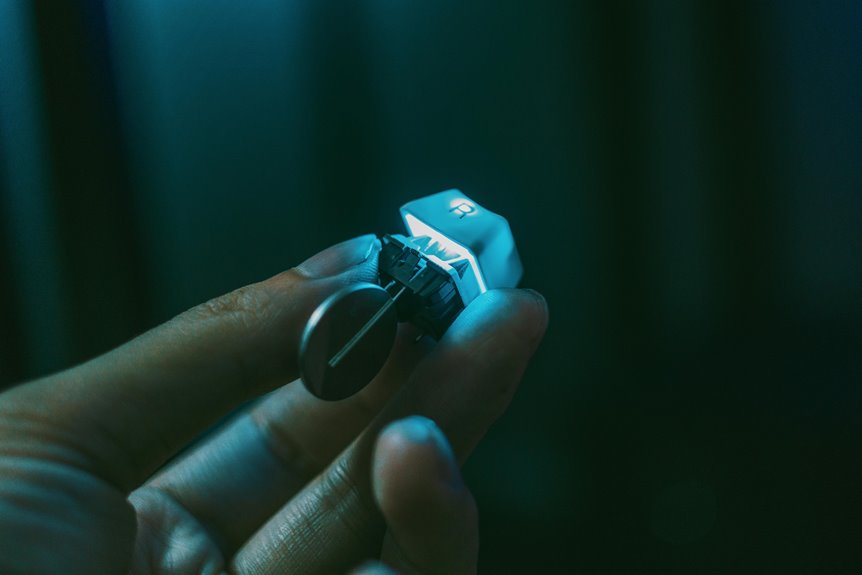When it comes to typing, you might not realize how much keyboard switch springs impact your experience. The weight, material, and design of these springs can transform how each keystroke feels beneath your fingers. Whether you prefer a light touch or a more substantial feedback, understanding these factors is key to enhancing your setup. So, what should you consider when choosing the right springs for your keyboard?
Table of Contents
Key Takeaways
- Springs beneath each key influence the resistance and feedback felt during typing, impacting overall typing feel and comfort.
- The material composition of springs, such as steel or brass, affects responsiveness, durability, and tactile feedback during key presses.
- Actuation force varies with spring tension; lighter springs enable faster typing, while heavier springs provide more feedback for accuracy.
- Well-calibrated springs can enhance tactile feedback at the actuation point, improving typing speed and overall typing enjoyment.
- Customizing spring types allows for a tailored typing experience, enhancing user satisfaction and performance metrics during extended use.
Understanding Keyboard Switch Springs
When you dive into the world of mechanical keyboards, understanding keyboard switch springs is essential.
These springs sit beneath each key, determining how they feel when you type. They come in various materials and tensions, affecting the overall responsiveness of your keyboard. A lighter spring offers less resistance, making it easier to press keys, while a heavier spring gives more feedback, requiring more force.
The length of the spring also plays a role, influencing the key's travel distance and actuation point. By grasping how these springs function, you can tailor your keyboard experience to suit your preferences.
Ultimately, knowing about keyboard switch springs helps you make informed choices for an enjoyable typing experience.
The Role of Spring Weight in Typing Feel
When it comes to typing feel, the weight of the springs in your keyboard switches plays a crucial role.
You'll notice that lighter springs require less force to press down, while heavier springs provide a firmer resistance.
Understanding these differences can help you find the perfect balance for your typing style.
Light vs. Heavy Springs
While choosing a keyboard, the weight of the springs in the switches can significantly impact your typing experience.
Light springs often require less force to actuate, making them ideal for fast typists or those who prefer a softer touch. You'll find that typing feels quicker and less fatiguing with these springs.
On the other hand, heavy springs demand more force, providing a satisfying resistance during each keystroke. This can enhance your typing accuracy and give a more deliberate feel, which some users appreciate.
Ultimately, the choice between light and heavy springs comes down to personal preference. Consider what feels comfortable for you; experimenting with different weights can help you find the perfect balance for your typing style.
Spring Compression Characteristics
Spring compression characteristics play a crucial role in shaping your typing feel. When you press a key, the spring's weight determines how much force you need to exert. If you prefer a lighter touch, a spring with lower compression characteristics allows for quicker actuation, making your typing experience feel more responsive.
On the other hand, heavier springs provide a more deliberate feel, requiring more effort but offering better feedback for each keystroke.
Finding the right spring weight is essential to your comfort and efficiency. It influences not just speed but also fatigue during long typing sessions.
Experiment with different springs to discover which compression characteristics best match your typing style, ensuring a satisfying and productive experience every time you sit down to type.
Material Matters: Spring Composition and Performance
When it comes to keyboard switch springs, the materials used can significantly influence your typing experience.
Different compositions affect tension and durability, impacting how the springs perform over time.
Understanding these factors can help you choose the right springs for your ideal typing feel.
Spring Materials Overview
The choice of materials for keyboard switch springs significantly impacts your typing experience. Typically, you'll find springs made from steel, stainless steel, or other alloys. Steel springs offer a solid, responsive feel, while stainless steel springs often resist corrosion, ensuring longevity.
You might also encounter brass springs, which can provide a unique tactile sensation. Each material has its own weight and elasticity, affecting how the spring compresses and returns during use.
For instance, copper alloys can deliver a softer touch, ideal for those who prefer a gentler typing experience. Ultimately, understanding these materials helps you make informed choices when customizing your keyboard, allowing you to achieve the perfect balance of comfort and performance tailored to your preferences.
Tension and Durability
While you might appreciate the feel of a well-crafted keyboard, the tension and durability of its switch springs are crucial for an optimal typing experience. The right spring tension can make your keystrokes feel responsive, while durability ensures your keyboard lasts through countless hours of use.
Here's a quick look at how different spring materials stack up:
| Material | Tension Level | Durability Rating |
|---|---|---|
| Steel | High | Excellent |
| Copper Alloy | Medium | Good |
| Plastic | Low | Fair |
Choosing the right spring material directly affects not just how it feels when you type, but also how long your keyboard will perform at its best. So, pay attention to those springs!
Impact on Typing Experience
Choosing the right spring composition significantly shapes your typing experience, as each material offers distinct characteristics. The springs in your keyboard switches can impact everything from tactile feedback to sound.
Here are some factors to consider:
- Material Type: Steel offers durability, while brass adds a unique sound profile.
- Spring Weight: Lighter springs require less force, making typing feel effortless.
- Coil Design: Different coil shapes can change the way the spring compresses and rebounds.
- Lubrication: Properly lubricated springs can reduce friction, enhancing smoothness.
- Consistency: High-quality springs provide uniform resistance, resulting in a more predictable typing feel.
Experimenting with different spring compositions can lead to a personalized, satisfying typing experience tailored to your preferences.
Tactile Feedback: How Springs Influence Key Feel
When you press a key on your keyboard, the spring underneath plays a crucial role in shaping your typing experience. Tactile feedback is all about the sensation you feel as you engage each key, and the spring's design greatly influences this.
A well-calibrated spring provides a noticeable bump at the actuation point, letting you know you've registered a key press without bottoming out. This tactile response can enhance your typing speed and accuracy, making it more enjoyable.
If you prefer a softer feel, you might choose a lighter spring, while a stiffer spring can offer a more pronounced feedback. Ultimately, the right spring can transform your keyboard into a responsive tool that matches your typing style and preferences.
Actuation Force: Finding the Right Balance
The actuation force of a key switch is crucial for achieving the perfect typing experience, as it determines how much pressure you need to apply to register a keystroke.
Finding the right balance is essential, as too much force can lead to fatigue, while too little can cause accidental presses.
Here are some factors to consider when evaluating actuation force:
- Personal preference: Everyone has a different typing style.
- Typing speed: Heavier switches may slow you down.
- Usage: Consider daily tasks and gaming needs.
- Fatigue levels: Lighter switches can reduce strain during long sessions.
- Key switch type: Different types offer varying actuation forces.
Ultimately, testing different switches will help you identify the ideal actuation force for your unique typing experience.
Customizing Your Setup: Spring Swaps and Upgrades
Customizing your keyboard setup can significantly enhance your typing feel and overall experience, especially when it comes to spring swaps and upgrades. By experimenting with different spring weights, you can fine-tune your keyboard to match your typing style.
If you prefer a softer touch, lighter springs may be your best bet, while heavier springs can provide more resistance for a firmer feel.
You'll also notice changes in sound and feedback with each spring swap. Upgrading to premium springs can improve durability and responsiveness, making your typing experience even better.
Don't hesitate to try various combinations until you find the perfect setup that suits your preferences. Customizing your springs is a straightforward yet impactful way to elevate your keyboard to a new level.
The Impact of Spring Design on Typing Experience
While you mightn't realize it at first, the design of keyboard switch springs plays a crucial role in shaping your typing experience. The right spring can enhance comfort and efficiency, making your sessions more enjoyable.
Here's how spring design impacts your typing feel:
- Weight: Heavier springs require more force, affecting fatigue levels.
- Height: Taller springs can change key travel distance, altering feedback.
- Material: Different materials influence feel and sound during keystrokes.
- Coiling: The way springs are coiled affects consistency and responsiveness.
- Damping: Springs with damping features can reduce noise and enhance smoothness.
Choosing the right spring design can transform how you connect with your keyboard, ultimately improving your overall typing experience.
Frequently Asked Questions
How Do Different Spring Colors Indicate Their Properties?
Different spring colors represent varying properties like weight and resistance. When you choose a switch, you'll notice that lighter colors often mean softer springs, while darker colors indicate stiffer ones, affecting your overall typing experience.
Can Springs Wear Out Over Time?
Yes, springs can wear out over time. As you type, the repeated pressure can lead to fatigue, causing changes in resistance and feel. Regular use might eventually affect performance, so keep an eye on them.
What Tools Are Needed for Spring Swaps?
To swap springs, you'll need a keycap puller, a switch puller, and possibly a soldering iron if your switches aren't hot-swappable. Don't forget to have a clean workspace for a smooth swapping process!
Are Springs Interchangeable Between Different Switch Types?
No, springs aren't generally interchangeable between different switch types. Each switch has specific dimensions and force requirements. If you want to swap springs, make sure they're compatible with your particular switch model for optimal performance.
How Can I Clean Keyboard Springs Effectively?
To clean keyboard springs effectively, you'll want to remove them from the switches. Use a soft brush or compressed air to dislodge debris, then soak them in isopropyl alcohol for thorough cleaning. Rinse, dry, and reassemble.




